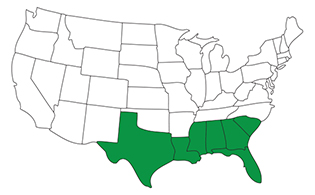
Tropical Sod Webworm
Herpetogramma phaeopteralis
The Tropical Sod Webworm is a lawn pest that undergoes a metamorphosis, transforming from a caterpillar-like worm into a moth-like insect. Also known as Herpetogramma phaeopteralis, this lawn-damaging insect can be found in much of the southeastern United States, typically infesting St. Augustinegrass, Bermudagrass and Centipedegrass.
Identify

Crown & Thatch
An adult Tropical Sod Webworm can be identified by the way it holds its wings like a roof over its body, resembling a swept-wing jet. This lawn pest has a dingy-brown to straw-colored appearance and is decorated with several darker, indistinct wavy lines across each wing. The caterpillar-like larva of this lawn-damaging insect is a dark, translucent amber color but appears greenish after feeding. Its head is dark yellowish-brown, and the full grown larva measures about 3/4 of an inch long. A larva will mostly feed at night and lies on the surface of the soil, resting during the day. Early signs of Tropical Sod Webworm damage in lawns include ragged edges on the leaves followed by striping of foliage. Areas damaged by this lawn pest may join together into large yellowish or brown patches. Well-maintained lawns may outgrow the damage, but stressed lawns might not survive a Tropical Sod Webworm infestation. All life stages of the Tropical Sod Webworm can usually be found along the edges of the damaged areas of the infested yard. Tropical Sod Webworms are most active at night and on dark, cloudy days. When disturbed, a droplet of liquid appears at the anal opening of this lawn-damaging insect. This droplet, along with the dorsal anus, is visible only with a 10X lens.
Life Cycle
The Tropical Sod Webworm experiences continuous generations throughout the year, but the cycle slows when cooler temperatures are present. The populations of this lawn pest decline when soil temperatures drop below 60°F.

Control
There are two methods for controlling Tropical Sod Webworms that TruGreen® recommends: 1. Use professionally applied pest control designed to prevent excess lawn pest populations, which can cause damage to your lawn 2. Kill insects, grubs and other lawn pests before they have a chance to damage your lawn Proper mowing and watering techniques can also help foster a healthy lawn that's more tolerant to lawn pest attacks—plus you'll get a lawn you'll want to live on in the process.







